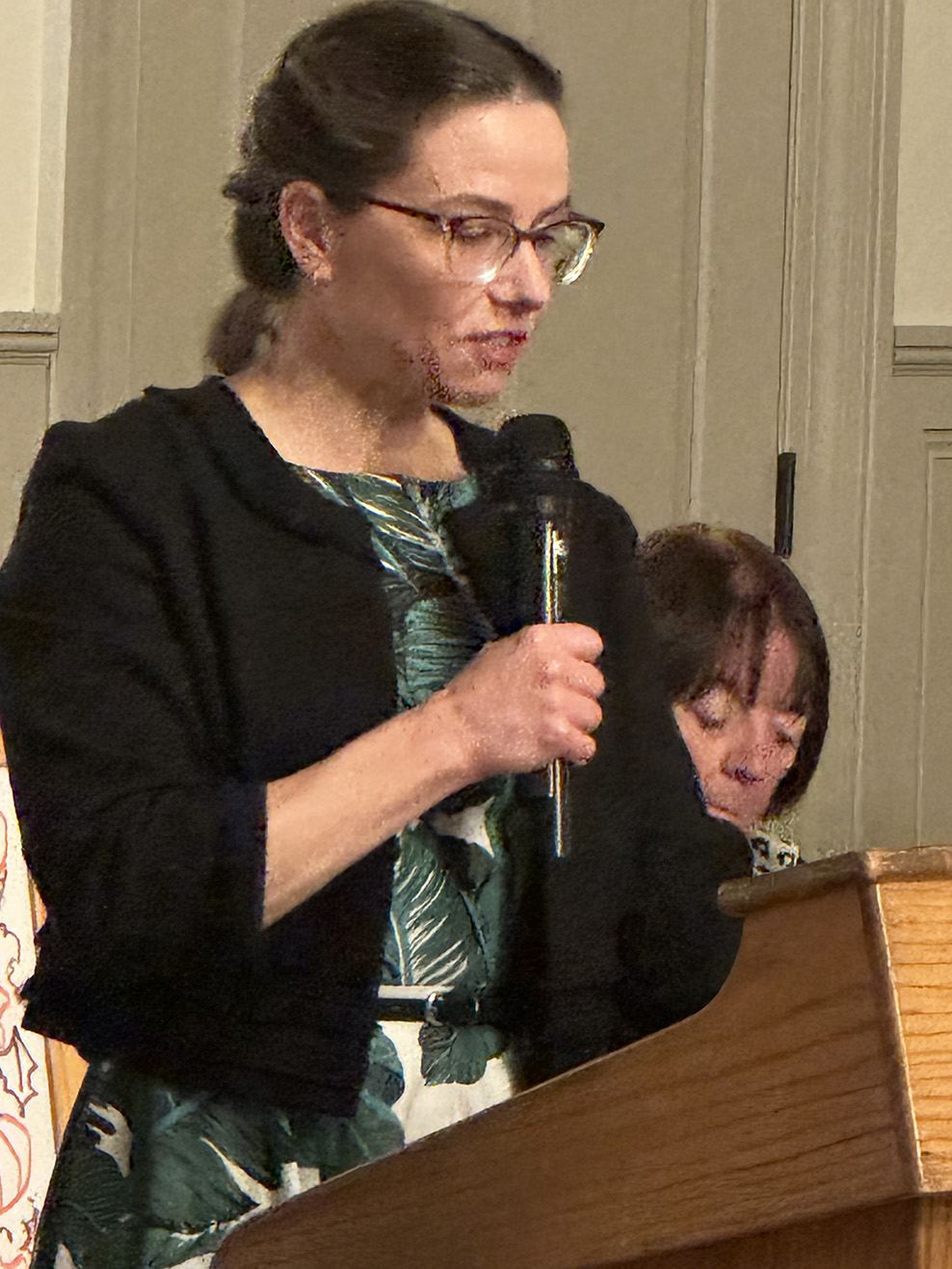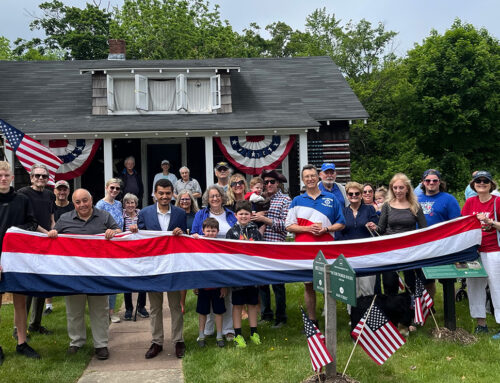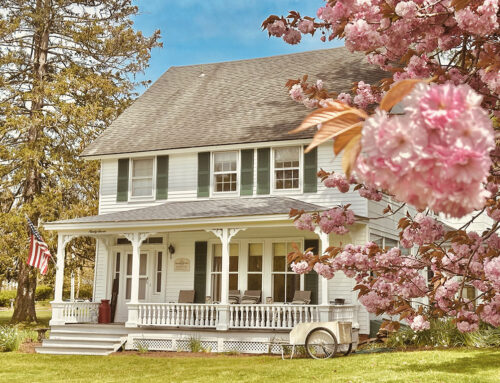“Conservation: What’s love got to do with it?” By Heather J. Lynch
November 13, 2024
Three Village Community Trust Annual Fall Gala Keynote Address
 Thank you so much for the introduction. It’s an honor to be here to help you celebrate the Three Village Community Trust Annual Fall Gala and all the work that you do. As was mentioned in my introduction, one of my current roles is as the Director of the Collaborative for the Earth. What is the Collaborative for the Earth? This is Stony Brook’s effort to unite the environmental scholarship on campus under one roof, to encourage the kind of truly interdisciplinary research that we will need to solve the big environmental challenges of our day. In addition to building research teams on topics that range from PFAS contamination in our water to offshore wind to extreme weather, the Collaborative is actively bridging the unfortunate and entirely unnecessary gap between science and the arts. One of the reasons I’ve focused so heavily on bridging this divide is because while the scientific endeavor is critically important to addressing things like climate change, it’s far from sufficient, because at the end of the day we make decisions with our hearts, not with our heads. The Collaborative for the Earth is an effort to bring faculty and students together, not just with one another, but with the community, with all of you!, so I really hope you will consider this an invitation to get involved. You can find a list of events, nearly all of which are open to the public on our website (just google Collaborative for the Earth and it’s the first website to come up) and you can find all the episodes of my podcast C4E Presents there as well. In addition, if you see opportunities where Stony Brook research can be of service, please reach out and I will do my best to
Thank you so much for the introduction. It’s an honor to be here to help you celebrate the Three Village Community Trust Annual Fall Gala and all the work that you do. As was mentioned in my introduction, one of my current roles is as the Director of the Collaborative for the Earth. What is the Collaborative for the Earth? This is Stony Brook’s effort to unite the environmental scholarship on campus under one roof, to encourage the kind of truly interdisciplinary research that we will need to solve the big environmental challenges of our day. In addition to building research teams on topics that range from PFAS contamination in our water to offshore wind to extreme weather, the Collaborative is actively bridging the unfortunate and entirely unnecessary gap between science and the arts. One of the reasons I’ve focused so heavily on bridging this divide is because while the scientific endeavor is critically important to addressing things like climate change, it’s far from sufficient, because at the end of the day we make decisions with our hearts, not with our heads. The Collaborative for the Earth is an effort to bring faculty and students together, not just with one another, but with the community, with all of you!, so I really hope you will consider this an invitation to get involved. You can find a list of events, nearly all of which are open to the public on our website (just google Collaborative for the Earth and it’s the first website to come up) and you can find all the episodes of my podcast C4E Presents there as well. In addition, if you see opportunities where Stony Brook research can be of service, please reach out and I will do my best to
connect you to faculty on campus that can help.
But tonight, I want to focus not on the “how” of environmental conservation but rather on the “why” of
environmental conservation, because in this new role, I’ve had a chance to step back from my own
academic research on Antarctic penguins to think about what it means to protect the environment and
what motivates people to protect the environment. There are so many people in our community giving so
much of their time and effort for the greater good and so the question is – how do we create a world
where we have more of that… more of you! It something I’ve been thinking a lot about.
Working as I do in Antarctica, there usually isn’t much ambiguity about what I mean when I say that I
want to protect the Antarctic environment. Without permanent residents or much infrastructure outside of
research bases, it’s clear that the environment to be protected is the ‘natural’ landscape and the amazing
plants and animals that somehow eke out a living in what really is a most forbidding climate. But the
question of what defines ‘the environment’ gets murkier when we talk about the places where all of us
people actually live. It turns out that there’s a bit of a schism within the environmental philosophy space.
On the one hand, you have those who would argue that nature is – by definition – all those places where
we are not, but that actually sets up a bit of a paradox, because that definition would mean there was no
way for humans to experience nature, because their mere presence would destroy the very idea of a place
as being nature at all. And a softer version of this same idea is that nature is any place where humans have
had no influence… except that no such places remain, especially in light of climate change. This, in fact,
is the thesis of Bill McKibben’s book The End of Nature.
On the other hand, and I’ll admit to a strong preference for this definition, some would define nature as
being much more inclusive. In fact, all inclusive. That we are animals subject to the same evolutionary
processes as all others is an idea now over 150 years old and no longer as scandalous, and in recognition
of our own naturalness, many would argue that the dichotomy between human and ‘natural’ is both
contrary to logic but also unhelpful to conservation. In this view, nature encompasses not just the few
naturalistic wild spaces that dot our community but also the infrastructure, the homes, the cultural
landmarks, all the things that make up our community. Avalon is nature, sure, but so too is Stony Brook
Village, Port Jeff Harbor, your neighborhood and mine. So, in this way, environmental conservation is
really about protecting all that delights us in some way, spaces and places both culturally significant,
places of respite and relaxation, and perhaps most importantly here, places that preserve our history and,
through doing so, connect our past to our present and eventually to our future.
With that context in mind, I’m intensively interested in the motivations that lead us to protect the
environment. Under what conditions are we willing to sacrifice our time and energy, opportunities to
consume more and re-use less, in order to protect the environment. If we take this question broadly, the
question of human motivation and moral duty is one that has engaged philosophers and writers and
teachers for literally thousands of years. But I want to hone in on one motivating idea that has been put
forward and that is the idea of oikophilia.
Let’s deconstruct that word a bit: oikos – not just a brand of yogurt! – oikos is a word from ancient
Greece roughly translated as ‘home’ or ‘household’. It’s the root word of both economics and ecology,
which makes a lot of sense being that these are two disciplines that I think really need to be reunited
under a single academic roof. Philia is perhaps more familiar, the antonym of “phobia”, and it means
“love of”. So, this term oikophilia is really getting at this love of home, love of community, that I dare say we all share and that the Three Village Trust is dedicated to fostering.
The British Philosopher Roger Scruton describes humans as having “limited and local affections”, which
is not exactly a compliment, but I think there’s something very true about that description. We work hard
to save a park or a pond or a building not because it’s just any park, pond, or building but rather because
its our park, our pond, or our town’s historical building. Importantly, the pronoun “our” here is not meant
to imply ownership, but – again to quote Scruton – rather one of entanglement. Our lives are entangled
with our surroundings, in ways that foster a deep connection to the places where we live and their history,
which explains why the work of the Three Village Community Trust is so important and why we are all
here tonight. Our genuine affection for our community, limited and local though it may be, was on full
display when that terrible storm flooded our streets and drained Mill Pond. We think of climate change as
something that happens far away, to other people in other places, but on that night, we experienced firsthand
the terrible and destructive power of extreme weather. I’m not sure who looked more shocked and
saddened the next day, the ducks wandering across the muddy flats of what remains or the people lining
the side. I think this nicely illustrates why divorcing conservation and environmental protection from the
broader goal of preserving our history and our communities is so arbitrary because our love for a place is
really at the root of our desire to save the environment, even as so much of our public conversation
centers on abstract notions of ‘the climate’ or ‘biodiversity’. That love is central to your organization’s
mission is no secret of course, as even a cursory visit to your website would show. Right beneath
“Welcome to the Three Village Community Trust” is the tagline “Protecting the Places You Love”.
This notion of a love-based conservation ethic certainly strikes many of my academic colleagues as far
too squishy a concept. Instead, they often take one of two approaches. One would be to fall back on some
notion of moral obligation to protect the planet, and certainly many faiths would provide justification for
such an approach, but often such moral obligations provide little insight as to how to make trade-offs
when they are required. Does our moral obligation to care for the planet occur at the level of individual
animals? Perhaps within the Buddhist tradition, but it’s not a widely held view. Perhaps our moral
obligation is to protect species? Though of course species are simply those taxonomic groups that, in this
snapshot of evolutionary time, exist. New species evolve and go extinct all the time, though certainly our
own actions have greatly accelerated the extinction rate and this is cause for concern. Maybe our
obligation instead is to ecosystems or ecological processes? The ethical requirements here are unclear.
Another approach, and certainly one more amenable to evaluating these trade-offs, is to convert value into
a common currency – usually money. This is what ecologists call natural capital or ecosystem services.
Even for things that are free, economists can work out what people would spend to visit such places, the boost in home values in surrounding areas, the reduction in health care expenses associated with
recreational areas and natural spaces, the flooding avoided by keeping natural spaces intact, etc. etc.
Though many conservation biologists balk at assigning value to animals or plants or parks, I’m not one of
them. If everything has infinite value, then nothing has value, because there is no basis for weighing
competing options. Protect this park or that? Preserve this house or that? So, I’m not opposed to the idea
behind ecosystem services as the basis for conservation, but it’s easy to fall into the trap of thinking that
such services are a necessary pre-condition for protection. That species or ecosystems or natural spaces
have to do something, that they need a job somehow. What if, instead, it was enough to focus on its
existence value. That for no justifiable reason at all, we just wanted to live in a world where that thing
existed. Take Patriots Rock. It’s not doing anything. It’s not cleaning our air, it’s not filtering water, it’s not even serving as habitat for animals. It doesn’t even take the shape of a face, like the Old Man of the Mountain once did in New Hampshire. It’s a rock and, absent its historical legacy, not a particularly
notable one. And yet, it has, I would argue, tremendous existence value, just in the same way that the
Mona Lisa does. The Mona Lisa doesn’t do anything for us in a tangible sense, and yet its value has been
estimated at 1 billion dollars. So clearly love and love alone is enough.
Moreover, and I think this is important, a focus on love keeps us from being blinded by the idea of an
optimum. Ecologists spend a lot of effort optimizing protected areas to achieve some goal, and in doing so
I think they buy into the implicit idea that the goal is to be maximally thrifty. Why protect 300 acres when
200 acres would do to save some species from extinction, or to reduce the frequency of severe flooding to
only once every year. There is a scarcity mindset that subsumes everything we do, as though the Earth
was a factory floor whose operations should be optimized and whittled down to the bare bones free of
waste or excess. But when we take instead the perspective of a love-based conservation ethos, then this
drive to protect only the bare bones of what’s absolutely needed seems misguided at best. If we love our
natural spaces, our parks, our historical monuments, our farms and our beaches, then we should be
profligate with our efforts. As a faculty member, to say a student is doing the bare minimum is no
compliment. I think our drive to optimize and minimize in the realm of protection and preservation and
conservation is missing the mark for the same reasons, because there is no such thing as too much love.
So, with that, I’d like to raise a toast to a year full of excess and extravagance, to an overabundance of
care and dedication and community spirit. I know we can overdo it, and I’ll be disappointed with anything
less. Cheers!




